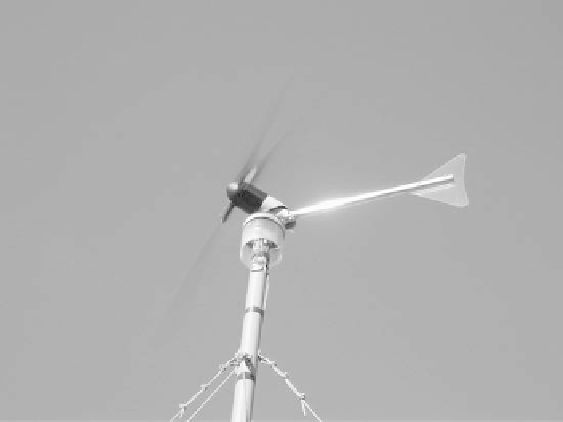Environmental Engineering Reference
In-Depth Information
Figure 11: Whisper H40 with tail furled (credit: AWEA, Dean Davis).
supply (gas, steam) is then cut off via an independent overspeed control mecha-
nism - a critical function since the overspeed condition can result in the destruction
of the turbine. In the case of wind turbines, the energy supply (the wind) cannot be
stopped, and so other means of overspeed control must be used. (It is interesting to
note that, just as in the case of turbines in conventional power stations, the primary
wind turbine speed control mechanism is the generator. Emergency overspeed
control only comes into play, e.g. when the generator fails.)
The obvious way to prevent wind turbine rotor overspeed is to pitch the blades,
and this is universally done on large wind turbines. It is possible to pitch the blades
either way (toward “feather” or toward “stall”), and there is more than one small
wind turbine using the pitch-to-stall approach for overspeed control (large wind
turbines use pitch-to-feather, pitching the blades through about 90°). However
only a few degrees of pitch variation in the other direction are required to achieve
a stall condition, and this can be done e.g. through a hub hinge or through pitch
weights mounted on a torsionally fl exible blade. While both of these pitch-to-stall
approaches are used in small wind turbines, neither approach is common.
The most common approach on small upwind turbines, as mentioned above, is
the furling tail. Figure 11 shows a turbine with the furling tail actuated. The main
features of a typical furling tail system are fi rstly the rotor has its centerline offset
from the centerline of the tower, and secondly it has a hinged tail (capable of furl-
ing in one direction but not the other). At times of excessive rotor thrust (as occurs
during overspeed), the thrust force causes the rotor to yaw “around the tower” and
the tail to furl via the hinge. During normal operation, proper yaw orientation is
maintained via the hinged tail. The hinge axis is typically slightly off of vertical,
such that the tail must move “uphill” as it furls, i.e. gravity keeps it up against a
stop (and directly behind the rotor) during normal operation. The above overspeed

Search WWH ::

Custom Search